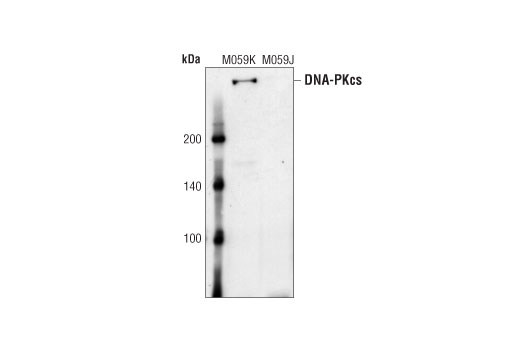DNA-PKcs Antibody #4602
Filter:
- WB

Western blot analysis of extracts from M059K (DNA-PK wildtype) and M059J (DNA-PK deficient) cells, using DNA-PK Antibody.
To Purchase # 4602
Cat. #
Size
Price
Inventory
4602T
20 µl
¥1,650
库存紧张
4602S
100 µl
¥4,550
库存紧张
Supporting Data
| REACTIVITY | H |
| SENSITIVITY | Endogenous |
| MW (kDa) | 450 |
| SOURCE | Rabbit |
Application Key:
- WB-Western Blotting
Species Cross-Reactivity Key:
- H-Human
- Related Products
Product Information
Product Usage Information
| Application | Dilution |
|---|---|
| Western Blotting | 1:1000 |
Storage
Supplied in 10 mM sodium HEPES (pH 7.5), 150 mM NaCl, 100 µg/ml BSA and 50% glycerol. Store at –20°C. Do not aliquot the antibody.
Protocol
Specificity / Sensitivity
DNA-PKcs Antibody detects endogenous levels of DNA-PKcs protein.
Species Reactivity:
Human
Source / Purification
Polyclonal antibodies are produced by immunizing animals with a synthetic peptide corresponding to amino acids near the carboxy-terminus of human DNA-PKcs. Antibodies are purified by protein A and peptide affinity chromatography.
Background
DNA-dependent protein kinase (DNA-PK) is an important factor in the repair of double-stranded breaks in DNA. Cells lacking DNA-PK or in which DNA-PK is inhibited fail to show proper nonhomologous end-joining (NHEJ) (1-7). DNA-PK is composed of two DNA-binding subunits (Ku70 and Ku86) and one 450 kDa catalytic subunit (DNA-PKcs) (8). It is thought that a heterodimer of Ku70 and Ku86 binds to double-stranded DNA broken ends before DNA-PKcs binds and is activated (1,9). Activated DNA-PKcs is a serine/threonine kinase that has been shown to phosphorylate a number of proteins in vitro, including p53, transcription factors, RNA polymerase, and Ku70/Ku86 (10,11). DNA-PKcs autophosphorylation at multiple sites, including Thr2609 and Ser2056, results in an inactivation of DNA-PK kinase activity and NHEJ ability (12,13). It has been demonstrated, however, that DNA-PK preferentially phosphorylates substrates before it autophosphorylates, suggesting that DNA-PK autophosphorylation may play a role in disassembly of the DNA repair machinery (14,15). Autophosphorylation at Thr2609 has also been shown to be required for DNA-PK-mediated double-strand break repair, and phosphorylated DNA-PK co-localizes with H2A.X and 53BP1 at sites of DNA damage (16). Phosphorylation at Ser2056 occurs in response to double-stranded DNA breaks and ATM activation (17).
- Gottlieb, T.M. and Jackson, S.P. (1993) Cell 72, 131-42.
- Hartley, K.O. et al. (1995) Cell 82, 849-56.
- Rosenzweig, K.E. et al. (1997) Clin Cancer Res 3, 1149-56.
- Jackson, S.P. and Jeggo, P.A. (1995) Trends Biochem Sci 20, 412-5.
- Roth, D.B. et al. (1995) Curr Biol 5, 496-9.
- Baumann, P. and West, S.C. (1998) Proc Natl Acad Sci U S A 95, 14066-70.
- Chen, S. et al. (2001) J Biol Chem 276, 24323-30.
- Jeggo, P.A. (1997) Mutat Res 384, 1-14.
- Suwa, A. et al. (1994) Proc Natl Acad Sci U S A 91, 6904-8.
- Anderson, C.W. and Lees-Miller, S.P. (1992) Crit Rev Eukaryot Gene Expr 2, 283-314.
- Kuhn, A. et al. (1995) Genes Dev 9, 193-203.
- Chan, D.W. and Lees-Miller, S.P. (1996) J Biol Chem 271, 8936-41.
- Douglas, P. et al. (2002) Biochem. J. 368, 243-51.
- Lees-Miller, S.P. et al. (1992) Mol Cell Biol 12, 5041-9.
- Jackson, S.P. et al. (1990) Cell 63, 155-65.
- Chan, D.W. et al. (2002) Genes Dev 16, 2333-8.
- Yajima, H. et al. (2009) J Mol Biol 385, 800-10.
Pathways
Explore pathways related to this product.
限制使用
除非 CST 的合法授书代表以书面形式书行明确同意,否书以下条款适用于 CST、其关书方或分书商提供的书品。 任何书充本条款或与本条款不同的客书条款和条件,除非书 CST 的合法授书代表以书面形式书独接受, 否书均被拒书,并且无效。
专品专有“专供研究使用”的专专或专似的专专声明, 且未专得美国食品和专品管理局或其他外国或国内专管机专专专任何用途的批准、准专或专可。客专不得将任何专品用于任何专断或治专目的, 或以任何不符合专专声明的方式使用专品。CST 专售或专可的专品提供专作专最专用专的客专,且专用于研专用途。将专品用于专断、专防或治专目的, 或专专售(专独或作专专成)或其他商专目的而专专专品,均需要 CST 的专独专可。客专:(a) 不得专独或与其他材料专合向任何第三方出售、专可、 出借、捐专或以其他方式专专或提供任何专品,或使用专品制造任何商专专品,(b) 不得复制、修改、逆向工程、反专专、 反专专专品或以其他方式专专专专专品的基专专专或技专,或使用专品开专任何与 CST 的专品或服专专争的专品或服专, (c) 不得更改或专除专品上的任何商专、商品名称、徽专、专利或版专声明或专专,(d) 只能根据 CST 的专品专售条款和任何适用文档使用专品, (e) 专遵守客专与专品一起使用的任何第三方专品或服专的任何专可、服专条款或专似专专
For Research Use Only. Not For Use In Diagnostic Procedures.
Cell Signaling Technology is a trademark of Cell Signaling Technology, Inc.
All other trademarks are the property of their respective owners. Visit our
Trademark Information page.

